Paper Menu >>
Journal Menu >>
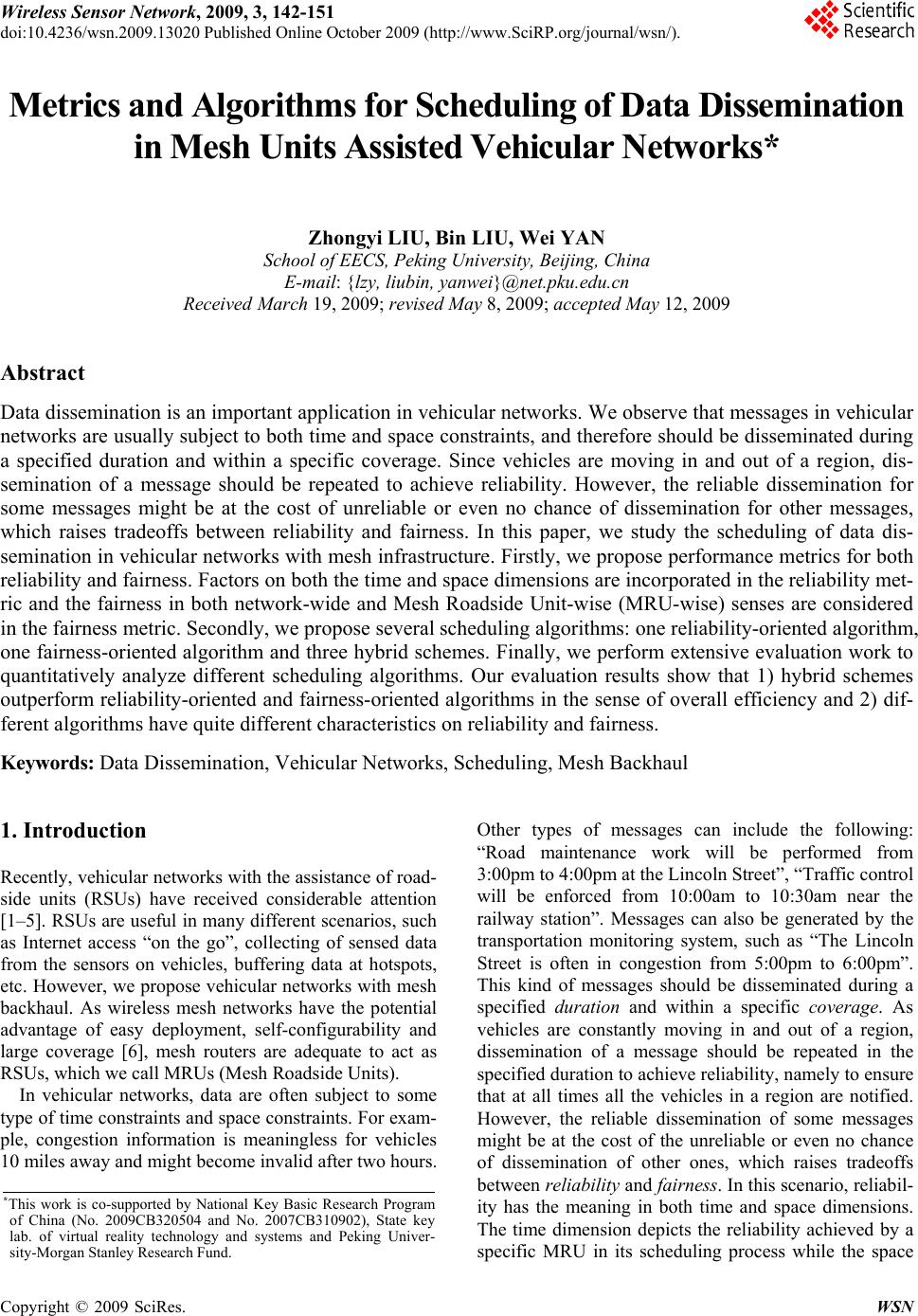 Wireless Sensor Network, 2009, 3, 142-151 doi:10.4236/wsn.2009.13020 ctober 2009 (http://www.SciRP.org/journal/wsn/). Copyright © 2009 SciRes. WSN Published Online O Metrics and Algorithms for Scheduling of Data Dissemination in Mesh Units Assisted Vehicular Networks* Zhongyi LIU, Bin LIU, Wei YAN School of EECS, Peking University, Beijing, China E-mail: {lzy, liubin, yanwei}@net.pku.edu.cn Received March 19, 2009; revised May 8, 2009; accepted May 12, 2009 Abstract Data dissemination is an important application in vehicular networks. We observe that messages in vehicular networks are usually subject to both time and space constraints, and therefore should be disseminated during a specified duration and within a specific coverage. Since vehicles are moving in and out of a region, dis- semination of a message should be repeated to achieve reliability. However, the reliable dissemination for some messages might be at the cost of unreliable or even no chance of dissemination for other messages, which raises tradeoffs between reliability and fairness. In this paper, we study the scheduling of data dis- semination in vehicular networks with mesh infrastructure. Firstly, we propose performance metrics for both reliability and fairness. Factors on both the time and space dimensions are incorporated in the reliability met- ric and the fairness in both network-wide and Mesh Roadside Unit-wise (MRU-wise) senses are considered in the fairness metric. Secondly, we propose several scheduling algorithms: one reliability-oriented algorithm, one fairness-oriented algorithm and three hybrid schemes. Finally, we perform extensive evaluation work to quantitatively analyze different scheduling algorithms. Our evaluation results show that 1) hybrid schemes outperform reliability-oriented and fairness-oriented algorithms in the sense of overall efficiency and 2) dif- ferent algorithms have quite different characteristics on reliability and fairness. Keywords: Data Dissemination, Vehicular Networks, Scheduling, Mesh Backhaul 1. Introduction Recently, vehicular networks with the assistance of road- side units (RSUs) have received considerable attention [1–5]. RSUs are useful in many different scenarios, such as Internet access “on the go”, collecting of sensed data from the sensors on vehicles, buffering data at hotspots, etc. However, we propose vehicular networks with mesh backhaul. As wireless mesh networks have the potential advantage of easy deployment, self-configurability and large coverage [6], mesh routers are adequate to act as RSUs, which we call MRUs (Mesh Roadside Units). In vehicular networks, data are often subject to some type of time constraints and space constraints. For exam- ple, congestion information is meaningless for vehicles 10 miles away and might become invalid after two hours. Other types of messages can include the following: “Road maintenance work will be performed from 3:00pm to 4:00pm at the Lincoln Street”, “Traffic control will be enforced from 10:00am to 10:30am near the railway station”. Messages can also be generated by the transportation monitoring system, such as “The Lincoln Street is often in congestion from 5:00pm to 6:00pm”. This kind of messages should be disseminated during a specified duration and within a specific coverage. As vehicles are constantly moving in and out of a region, dissemination of a message should be repeated in the specified duration to achieve reliability, namely to en sure that at all times all the vehicles in a region are notified. However, the reliable dissemination of some messages might be at the cost of the unreliable or even no chance of dissemination of other ones, which raises tradeoffs between reliability and fairness. In this scenario, reliabil- ity has the meaning in both time and space dimensions. The time dimension depicts the reliability achieved by a specific MRU in its scheduling process while the space * This work is co-supported by National Key Basic Research Program of China (No. 2009CB320504 and No. 2007CB310902), State key lab. of virtual reality technology and systems and Peking Univer- sity-Morgan Stanl e y Research Fund.  Z. Y. LIU ET AL. 143 1) dimension describes whether messages are disseminated at all the MRUs within their requested coverage. Simi- larly, fairness is significant in both the network-wise sense and the MRU-wise sense. In this paper, we first propose metrics for reliability and fairness and then de- velop and evaluate five scheduling algorithms quantita- tively. To the best of our knowledge, this is the first pa- per on scheduling mechanisms in this scenario to address the reliability and fairness issu es. The rest of this paper is arranged as follows: the sec- ond part presents our system model, including the net- work architecture and performance metrics. Five differ- ent scheduling algorithms are proposed in Section 3 and evaluation results are shown in Section 4. Related work is reviewed in Section 5, and in the last section, we con- clude this paper. 2. System Model 2.1. Network Architecture We assume a vehicular network with mesh backhaul, as shown in Figure 1. Mesh Roadside Units (MRUs) are placed at roadside locations to receive messages from cars nearby or to disseminate information to vehicles in its vicinity. Since wireless mesh network has the poten- tial advantage of easy deployment and self-configurable, we assume that MRUs are connected via wireless links. MRUs can have larger coverage than vehicular clients, so that they can serve more vehicular clients at the same time and disseminate messages efficiently. When a vehi- cle needs to send messages to an MRU, it can first select a nearby MRU and then looks for relays to forward in- formation to the designated MRU. However, the mecha- nism with which vehicles send messages to MRUs is out of the scope of this paper. We assume perfect message transmission from vehicular clients to MRUs in this work. We focus on the scheduling for data dissemination in this type of vehicular networks, which will be ex- plained in detail in later sections. Figure 1. Network architecture. We assume a mesh back- haul assisted architecture. Mesh road side units are as- sumed to be well connected. 2.2. Performance Metrics In our message dissemination model, each message is coupled with a <start-time, end-time, x , y, radius> tuple, in which “start-time” and “end-time” indicate the instants when message dissemination should begin and terminate; <x,y> and “radius” specify the center and radius of the dissemination area. With “x”, ”y”, ”radius” and some geographical information, the MRU which receives the message dissemination request can easily obtain the des- tination MRUs which locate in the destin ation area. With this message dissemination model, we figure out two important factors which determine the efficiency of message dissemination: Reliability. Reliability describes the quality of ser- vice for the selected messages. In this case, reliabil- ity covers two different dimensions. On one hand, in the time dimension, a message should be given as much dissemination time as possible in the [start-time, end-time] duration. On the other hand, in the space dimension, message dissemination should occur in an area as large as possible within the requested <x, y, radius> coverage. Fairness. To achieve better reliability for the a se- lected message to disseminate, more time as well as MRUs should be allocated to it, which may in turn decrease the quality of service for the other mes- sages. Therefore, fairness should be taken into ac- count to enhance the efficiency of message dis- semination. We now present the metrics for both reliability and fairness. Our metric for reliability, RM (reliab ility metric) is defined as *(1)* (0RM TRMSRM where TRM and SRM stand for Time Reliability Metric and Space Reliability Metric, respectively. The formulas for TRM and SRM are as follows. @ MRU (,) i i mMRU i R MRU TRm i N TRM N () m messages SR m SRM N where M RU N i is the total number of MRUs in the net- work and R N is the number of messages to disseminate (or received) at the ith MRU. indicates the time ratio for message m at the ith MRU and is the space ratio for message m. The exponent (,)TRm i ()SR m 1 (SR m is used to specify the reliability lev el, whose effects will be explained later in this section. TR and are in turn defined as (,)m i) _ (,) () m i m (, )D tim iDura MRU Vehicular Client e TR mtion and C opyright © 2009 SciRes. WSN 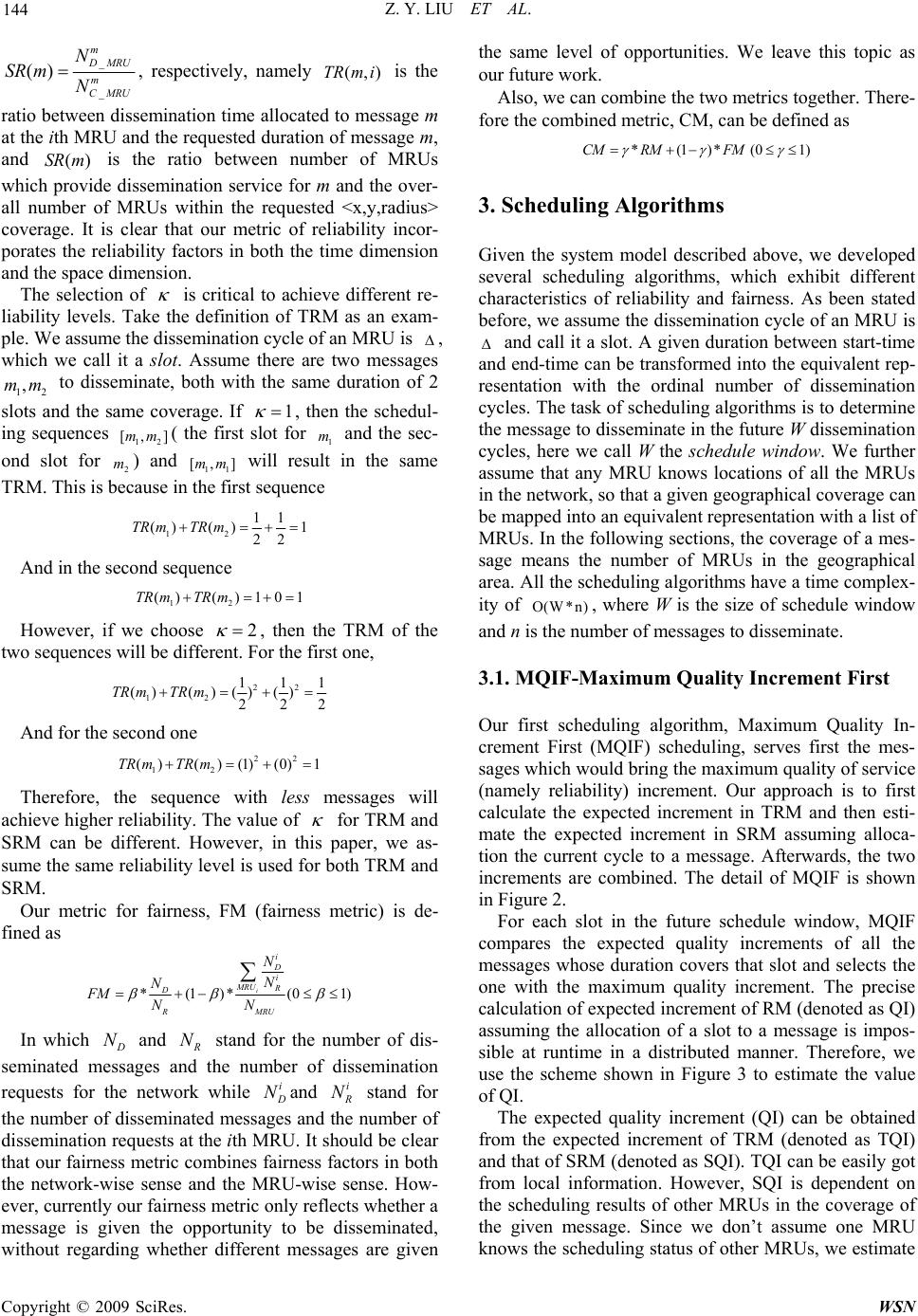 Z. Y. LIU ET AL. 144 _ _ () m D MRU m CMRU N SR mN , respectively, namely is the ratio between dissemination time allocated to message m at the ith MRU and the requested dur ation of message m, and is the ratio between number of MRUs which provide dissemination service for m and the over- all number of MRUs within the requested <x,y,radius> coverage. It is clear that our metric of reliability incor- porates the reliability factors in both the time dimension and the space dimension. (,)TRm i ()SR m The selection of is critical to achieve different re- liability levels. Take the definition of TRM as an exam- ple. We assume the dissemination cycle of an MRU is , which we call it a slot. Assume there are two messages to disseminate, both with the same duration of 2 slots and the same coverage. If , then the schedul- ing sequences ( the first slot for and the sec- ond slot for ) and will result in the same TRM. This is because in the first sequence 1 ,m2 m 1 1 [,mm 2 m 2 ]1 m 11 [,]mm 12 11 () ()1 22 TR mTR m And in the second sequence 12 () ()101TR mTR m However, if we choose 2 , then the TRM of the two sequences will be different. For the first one, 2 12 11 ( )() ()() 22 TR mTR m 2 1 2 And for the second one 22 12 ()()(1) (0) 1TR mTR m Therefore, the sequence with less messages will achieve higher reliability. The value of for TRM and SRM can be different. However, in this paper, we as- sume the same reliability level is used for both TRM and SRM. Our metric for fairness, FM (fairness metric) is de- fined as *(1)*(0 i i D i MRU R D RMRU N N N1) NN FM In which D N and R N stand for the number of dis- seminated messages and the number of dissemination requests for the network while i D Nand i R N stand for the number of disseminated messages and the number of dissemination requests at the ith MRU. It should be clear that our fairness metric combines fairness factors in both the network-wise sense and the MRU-wise sense. How- ever, currently our fairness metric only reflects whether a message is given the opportunity to be disseminated, without regarding whether different messages are given the same level of opportunities. We leave this topic as our futu re work. Also, we can combine the two metrics together. There- fore the combined metric, CM, can be defined as *(1)* (0CM RMFM 1) 3. Scheduling Algorithms Given the system model described above, we developed several scheduling algorithms, which exhibit different characteristics of reliability and fairness. As been stated before, we assume the dissemination cycle of an MRU is and call it a slot. A given duration between start-time and end-time can be transformed into the equivalent rep- resentation with the ordinal number of dissemination cycles. The task of scheduling algorithms is to determine the message to disseminate in the future W dissemination cycles, here we call W the schedule window. We further assume that any MRU knows locations of all the MRUs in the network, so that a given geographical coverage can be mapped into an equivalent representation with a list of MRUs. In the following sections, the coverage of a mes- sage means the number of MRUs in the geographical area. All the scheduling algorithms have a time complex- ity of , where W is the size of schedule window and n is the number of messages to disseminate. O( W*n ) 3.1. MQIF-Maximum Quality Increment First Our first scheduling algorithm, Maximum Quality In- crement First (MQIF) scheduling, serves first the mes- sages which would bring the maximum quality of service (namely reliability) increment. Our approach is to first calculate the expected increment in TRM and then esti- mate the expected increment in SRM assuming alloca- tion the current cycle to a message. Afterwards, the two increments are combined. The detail of MQIF is shown in Figure 2. For each slot in the future schedule window, MQIF compares the expected quality increments of all the messages whose duration covers that slot and selects the one with the maximum quality increment. The precise calculation of expected increment of RM (denoted as QI) assuming the allocation of a slot to a message is impos- sible at runtime in a distributed manner. Therefore, we use the scheme shown in Figure 3 to estimate the value of QI. The expected quality increment (QI) can be obtained from the expected increment of TRM (denoted as TQI) and that of SRM (denoted as SQI). TQI can be easily got from local information. However, SQI is dependent on the scheduling results of other MRUs in the coverage of the given message. Since we don’t assume one MRU knows the scheduling status of other MRUs, we estimate Copyright © 2009 SciRes. WSN 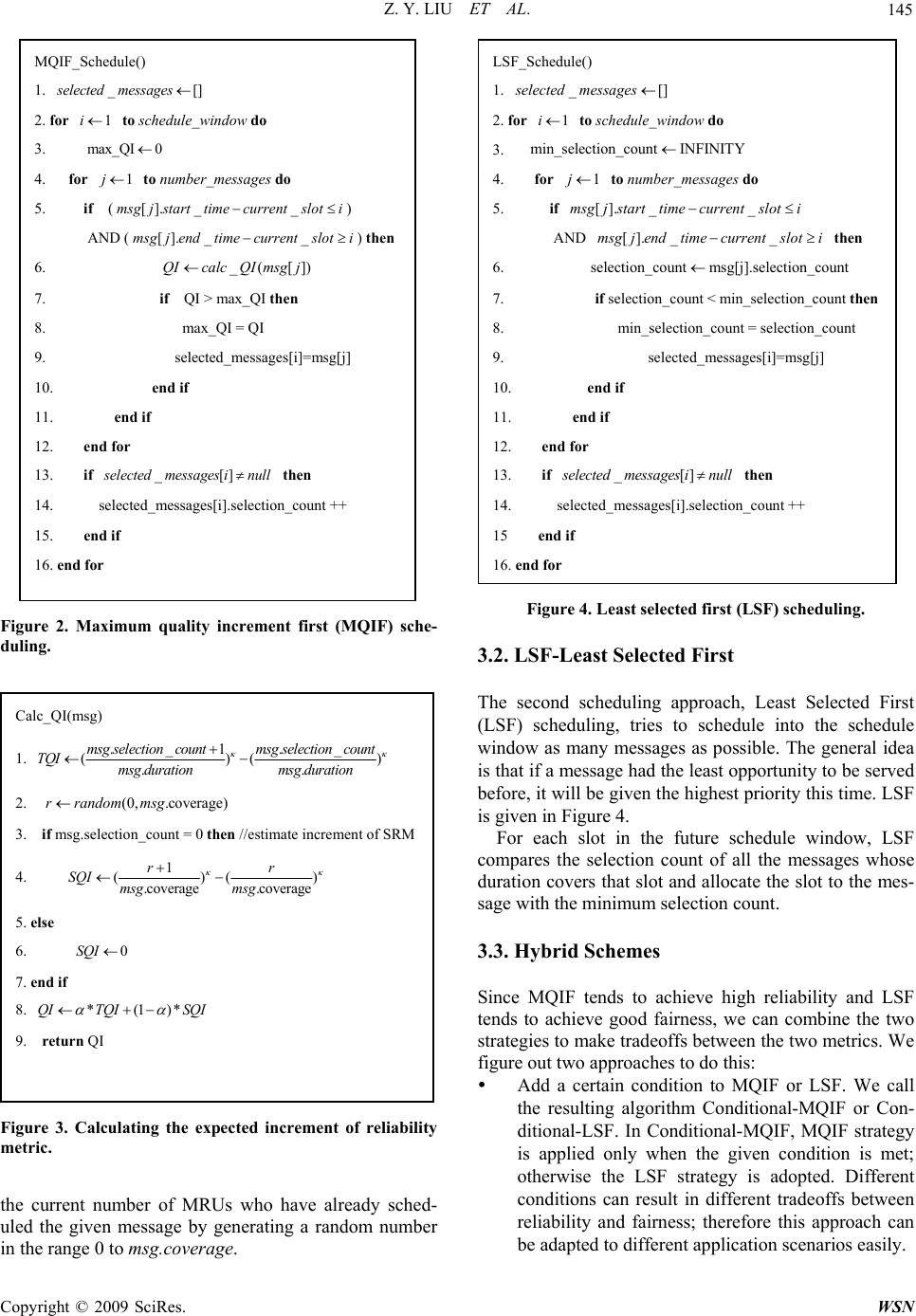 Z. Y. LIU ET AL. 145 Figure 2. Maximum quality increment first (MQIF) sche- duling. Figure 3. Calculating the expected increment of reliability metric. the current number of MRUs who have already sched- uled the given message by generating a random number in the range 0 to msg.coverage. Figure 4. Least selected first (LSF) scheduling. 3.2. LSF-Least Selected First The second scheduling approach, Least Selected First (LSF) scheduling, tries to schedule into the schedule window as many messages as possible. The general idea is that if a message had the least opportunity to be served before, it will be given the highest priority this time. LSF is given in Figure 4. For each slot in the future schedule window, LSF compares the selection count of all the messages whose duration covers that slot and allocate the slot to the mes- sage with the minimum selection count. 3.3. Hybrid Schemes Since MQIF tends to achieve high reliability and LSF tends to achieve good fairness, we can combine the two strategies to make tradeoffs between the two metrics. We figure out two approaches to do this: Add a certain condition to MQIF or LSF. We call the resulting algorithm Conditional-MQIF or Con- ditional-LSF. In Conditional-MQIF, MQIF strategy is applied only when the given condition is met; otherwise the LSF strategy is adopted. Different conditions can result in different tradeoffs between reliability and fairness; therefore this approach can be adapted to different application scenarios easily. LSF_Schedule() 1. _ []selected messages 2. for 1i to schedule_window do 3. min_selection_count INFINITY 4. for 1j to number_messages do 5. if []. __msg jstarttimecurrentsloti AND then [].__msg j endtimecurrentsloti 6 . s election_count msg[j].selection_count 7 . if selection_count < min_selection_count then 8. min_selection_count = selection_count 9. selected_messages[i]=msg[j] 10. end if 11. end if 12. end for 13. if _[] s electedmessages inull then 14. selected_messages[i].selection_count ++ 15 end if 16. end for Calc_QI(msg) 1. ._1._ ()( .. msg selectioncountmsg selectioncount TQI msg durationmsg duration) 2. (0, .coverage)rrandom msg 3. if msg.selection_count = 0 then //estimate increment of SRM 4. 1 ()( .coverage .coverage rr SQI msg msg ) 5. else 6. 0SQI 7. end if 8. *(1)*QITQISQI 9. return QI MQIF_Schedule() 1. _ []selectedmessages 2. for to schedule_window do 1i 3. max_QI 0 4. for 1 to number_messages do j 5. if (msg[].__j starttimecurrentsloti ) AND () then []. __msg j endtimecurrentsloti 6 . _ ([]QIcalcQI msgj) 7. if QI > max_QI then 8. max_QI = QI 9. selected_messages[i]=msg[j] 10. end if 11. end if 12. end for 13. if _[] s electedmessages inull then 14. selected_messages[i].selection_count ++ 15. end if 16. end for C opyright © 2009 SciRes. WSN  Z. Y. LIU ET AL. 146 Combine the two strategies by simply combining the selection metrics of the two. Although it is less tunable than the former one, it may achieve better overall effi- ciency. Figure 5. Conditional-MQIF. 3.3.1. Cond i tional- M QIF The first approach to combine MQIF and LSF is to add a threshold to MQIF or LSF. In Conditional-MQIF, MQIF strategy is applied only when the ratio between the maximum and minimum QI exceeds a specified MQIF_ THRESHOLD. If the condition is not met, LSF is applied. Similarly, we can also combine MQIF and LSF using Conditional-LSF. In Conditional-LSF, LSF is used only when the difference between the maximum and mini- mum selection count exceeds a predefined LSF_THRE- SHOLD. We show the detail of conditional-MQIF in Figure 5. By varying the MQIF_THRESHOLD or LSF_ THRESHOLD, we can control the proportion of opportu- nities for applying MQIF or LSF strategy; therefore the algorithm can be adapted to various application demands. For example, small MQIF_THRESHOLD values tend to achieve better reliability thus adequate for reliabil- ity-sensitive scenarios. Conditional_MQIF_Schedule() 1. _ []selectedmessages 2. for to schedule_window do 1i 3. , max_QI 0min_QI I NFIN IT Y 4. min_selection_countINFINITY 5. for to number_messages do 1j 6 . if []. __msg jstarttimecurrentsloti AND then [].__msg j endtimecurrentsloti 7 . _ ([])calcQI msgjQI 8. s election_count msg[j].selection_count 3.3.2. MQILSF-Maximum Quality Increment Least Selected First 9 . if then max_QI QI 1 0. max_QI=QI 11. MQIF_msg msg[j] 1 2. end if 13. if QI<min_QI then 14. min_QI = QI 15. end if 16. if selection_count < min_selection_count then 17. min_selection_count = selection_count 18. LSF_msg msg[j] 1 9. end if 20. end if 21. end for 22. //determine which strategy to use 23. if max_QI _ min_QI M QIF THRESHOLD then 24. selected_messages[i]=MQIF_msg 25. else 26. selected_messages[i]=LSF_msg Since MQIF tends to select messages with small cover- age and duration, while LSF favors messages with small selection count, we can simply incorporate selection count into the quality increment (QI). This strategy is similar to MQIF, except that in MQILSF the Quality Increment (QI) is redefined as *(1)* []._ 1 TQI SQI QI msg j selectioncount Note that we use instead of because the initial values of selection counts are all 0. []._ 1msgjselectioncount []. _msg j selectioncount 4. Performance Evaluation We developed a discrete event simulator in Java. It takes as input an XML configuration file and a scenario file, runs the designated scheduling algorithms and writes the scheduling results to trace files. 4.1. Simulation Setup We extract a 2500m*2500m network scenario from a realistic geographical map of the TianAnMen district of Beijing, whose e-map is shown in Figure 6 [13]. We as- sume MRUs are evenly distributed with a distance of 300m along the roads. Therefore over 50 MRUs are de- ployed. The communication range of an MRU is as- sumed to b e 350m. 27. end if 28. if _[] s electedmessages inullthen 29. selected_messages[i].selection_count ++ 30. end if 31. end for The message generation interval and message genera- tion probability indicate how often events are generated. Copyright © 2009 SciRes. WSN 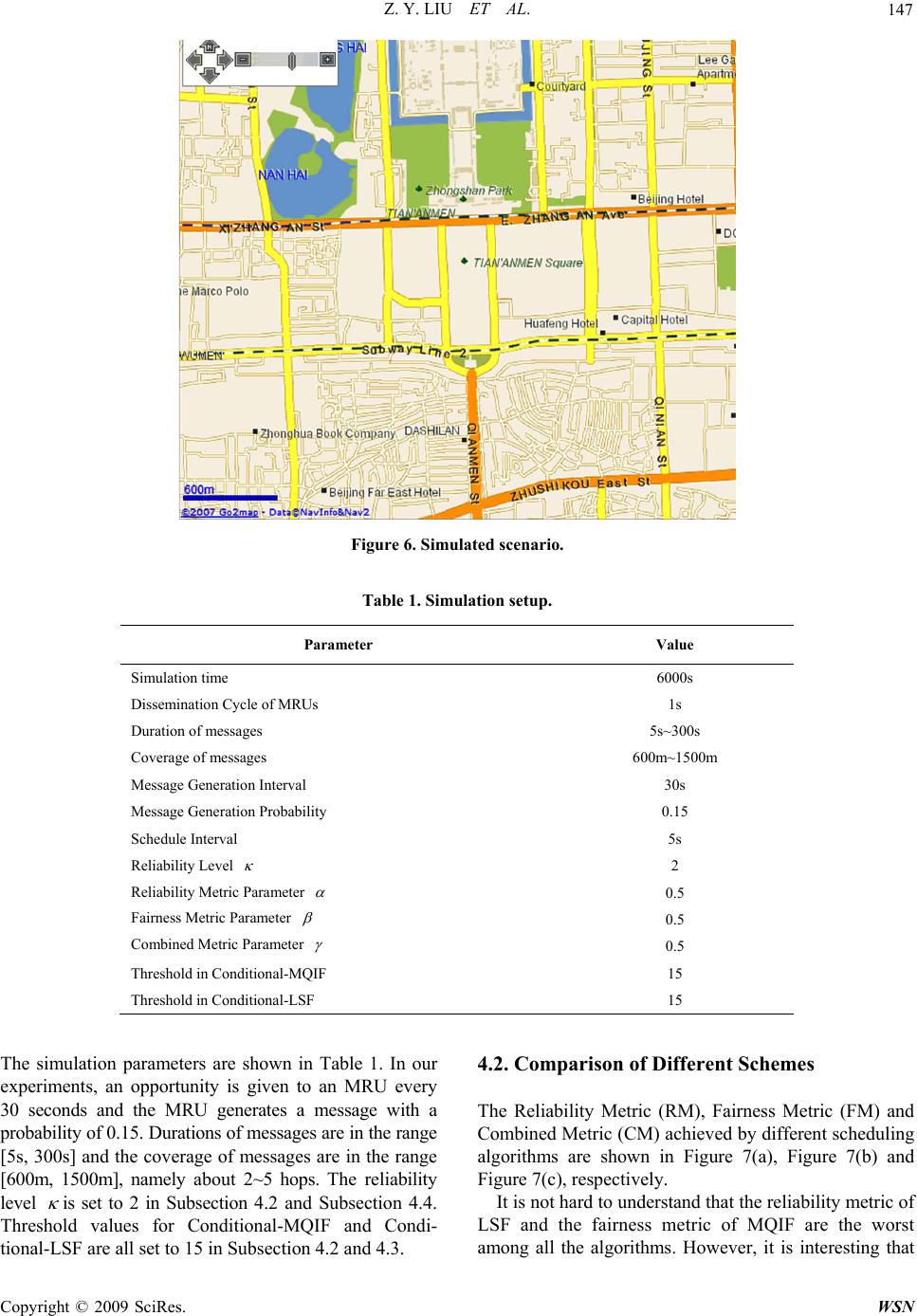 Z. Y. LIU ET AL. Copyright © 2009 SciRes. WSN 147 Figure 6. Simulated scenario. Table 1. Simulation setup. Parameter Value Simulation time 6000s Dissemination Cycle of MRUs 1s Duration of messages 5s~300s Coverage of messages 600m~1500m Message Generation Interval 30s Message Generation Probability 0.15 Schedule Interval 5s Reliability Level 2 Reliability Metric Parameter 0.5 Fairness Metric Parameter 0.5 Combined Metric Parameter 0.5 Threshold in Conditional-MQIF 15 Threshold in Conditional-LSF 15 4.2. Comparison of Different Schemes The simulation parameters are shown in Table 1. In our experiments, an opportunity is given to an MRU every 30 seconds and the MRU generates a message with a probability of 0.15. Durations of messages are in the range [5s, 300s] and the coverage of messages are in the range [600m, 1500m], namely about 2~5 hops. The reliability level is set to 2 in Subsection 4.2 and Subsection 4.4. Threshold values for Conditional-MQIF and Condi- tional-LSF are all set to 15 in Subsectio n 4. 2 a nd 4.3. The Reliability Metric (RM), Fairness Metric (FM) and Combined Metric (CM) achieved by different scheduling algorithms are shown in Figure 7(a), Figure 7(b) and Figure 7(c), respectively. It is not hard to understand that the reliability metric of LSF and the fairness metric of MQIF are the worst among all the algorithms. However, it is interesting that  Z. Y. LIU ET AL. 148 05 10 1520 25 30 35 4045 50 0.52 0.54 0.56 0.58 0.6 0.62 Iteration of Runs Reliability Metric MQ I F LSF Co nd-MQIF Co nd-L SF MQ I LSF (a) 05 10 15 2025 30 3540 4550 0.96 0. 965 0.97 0. 975 0.98 0. 985 0.99 0. 995 1 1. 005 Iterat ion of Runs Fairness Metric MQIF LSF Cond-MQIF Cond-LSF MQILS F (b) 05 10 15 20 25 30 3540 4550 0. 74 0. 75 0. 76 0. 77 0. 78 0. 79 0. 8 0. 81 Iterat i on of Runs Combined Metric MQ IF LSF Cond-MQIF Cond-LSF MQ ILS F (c) Figure 7. a) Comparison of reliability metric, b) Compari- son of fairness metric, c) Comparison of combined metric. 1 23 45 0. 95 0.955 0. 96 0.965 0. 97 0.975 0. 98 0.985 0. 99 0.995 1 K Global S erv i c e Rat i o MQ I F MQ I LSF Cond-MQIF (a) 1 23 45 0.9 0. 9 1 0. 9 2 0. 9 3 0. 9 4 0. 9 5 0. 9 6 0. 9 7 0. 9 8 0. 9 9 1 K A verage Local Service Rati o MQ IF MQ ILS F Co nd-MQIF (b) 1234 5 0.93 0.94 0.95 0.96 0.97 0.98 0.99 1 K Fairness Metric MQ IF MQ ILSF Co n d- MQIF (c) Figure 8. a) Effects of on global service ratio, b) Effects of on average local service ratio, c) Effects of on fairness metric. Copyright © 2009 SciRes. WSN 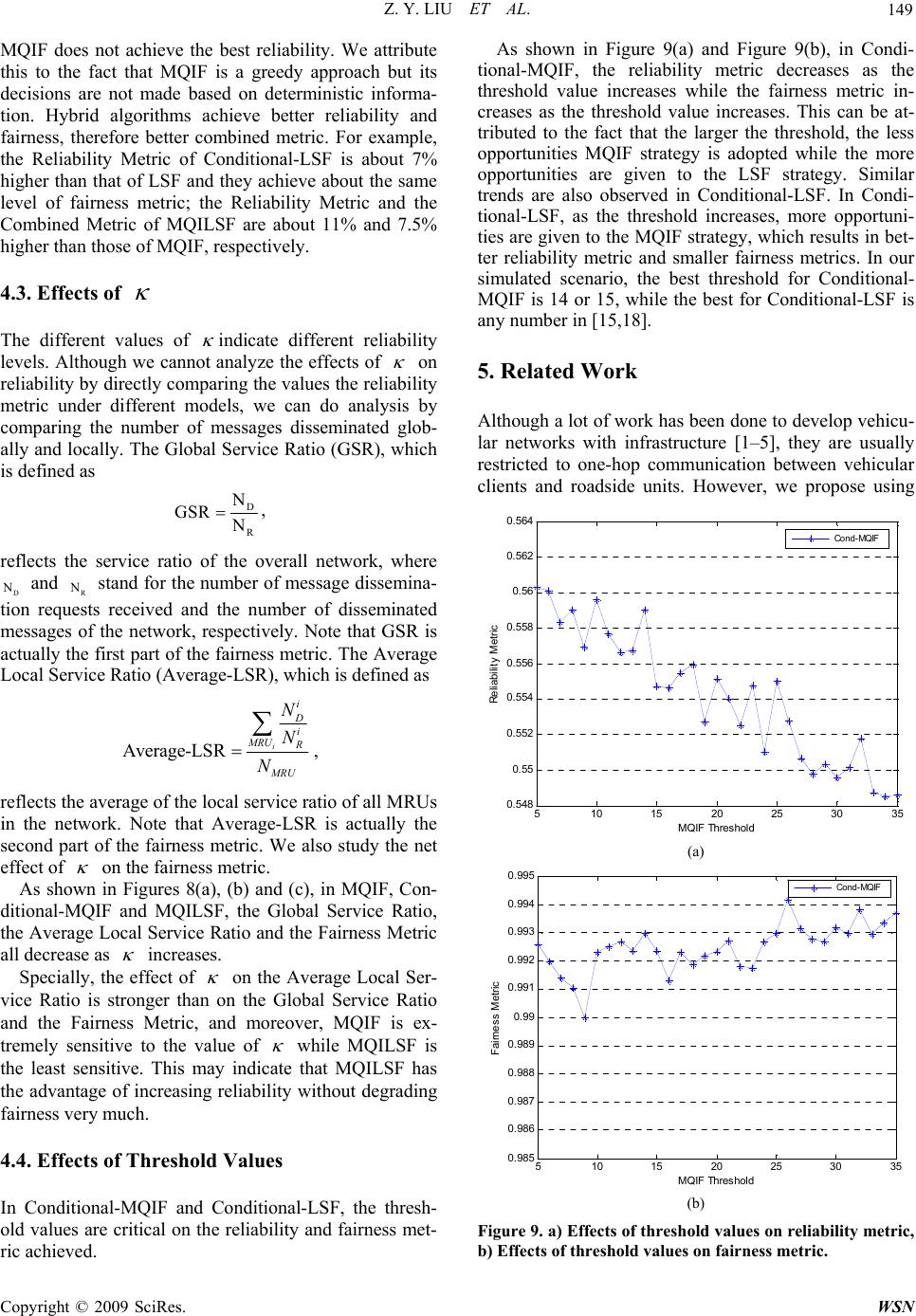 Z. Y. LIU ET AL. 149 MQIF does not achieve the best reliability. We attribute this to the fact that MQIF is a greedy approach but its decisions are not made based on deterministic informa- tion. Hybrid algorithms achieve better reliability and fairness, therefore better combined metric. For example, the Reliability Metric of Conditional-LSF is about 7% higher than that of LSF and they achieve about the same level of fairness metric; the Reliability Metric and the Combined Metric of MQILSF are about 11% and 7.5% higher than those of MQIF, respectiv ely. 4.3. Effects of The different values of indicate different reliability levels. Although we cannot analyze the effects of on reliability by directly comparing the values the reliability metric under different models, we can do analysis by comparing the number of messages disseminated glob- ally and locally. The Global Service Ratio (GSR), which is defined as D R N GSR N , reflects the service ratio of the overall network, where D and R N stand for the number of message dissemina- tion requests received and the number of disseminated messages of the network, respectively. Note that GSR is actually the first part of the fairness metric. The Ave rage Local Service Ratio (Average-LSR), which is defined as N Average-LSR i i D i MRU R MRU N N N , refl ect s th e av era g e of th e local service ratio of all MRUs in the network. Note that Average-LSR is actually the second part of the fairness metric. We also study the net effect of on the fairness metric. As shown in Figures 8(a), (b) and (c), in MQIF, Con- ditional-MQIF and MQILSF, the Global Service Ratio, the Aver age Local Service Ratio and the Fairness Metric all decrease as increases. Specially, the effect of on the Average Local Ser- vice Ratio is stronger than on the Global Service Ratio and the Fairness Metric, and moreover, MQIF is ex- tremely sensitive to the value of while MQILSF is the least sensitive. This may indicate that MQILSF has the advantage of increasing reliability without degrading fairness v e ry much . 4.4. Effects of Threshold Values In Conditional-MQIF and Conditional-LSF, the thresh- old values are critical on the reliability and fairness met- ric achieved. As shown in Figure 9(a) and Figure 9(b), in Condi- tional-MQIF, the reliability metric decreases as the threshold value increases while the fairness metric in- creases as the threshold value increases. This can be at- tributed to the fact that the larger the threshold, the less opportunities MQIF strategy is adopted while the more opportunities are given to the LSF strategy. Similar trends are also observed in Conditional-LSF. In Condi- tional-LSF, as the threshold increases, more opportuni- ties are given to the MQIF strategy, which results in bet- ter reliability metric and smaller fairness metrics. In our simulated scenario, the best threshold for Conditional- MQIF is 14 or 15, while the best for Conditional-LSF is any number in [15,18]. 5. Related Work Although a lot of work has been done to develop vehicu- lar networks with infrastructure [1–5], they are usually restricted to one-hop communication between vehicular clients and roadside units. However, we propose using 510 152025 3035 0.548 0. 55 0.552 0.554 0.556 0.558 0. 56 0.562 0.564 MQ IF Threshold Reliability Metric Cond-MQIF (a) 510152025 30 35 0. 985 0. 986 0. 987 0. 988 0. 989 0. 99 0. 991 0. 992 0. 993 0. 994 0. 995 MQIF Threshold Fairness Metric Cond-MQ IF (b) Figure 9. a) Effects of threshold values on reliability metric, b) Effects of threshold values on fairness metric. C opyright © 2009 SciRes. WSN  Z. Y. LIU ET AL. 150 wireless mesh routes as the backhaul of the network, which has the potential advantage of easy deployment, self-configurable and scalability. Scheduling for data access in vehicular networks is studied in [5]. However, our work is different from [5] because The work by [5] only studies scheduling for data access within one hop. In contrast, we focus on the multi-hop case, which is realistic for data dissemi- nation in vehicular networ ks. The work by [5] does optimization for scheduling of upload/download data access. However, we con- sider the scheduling for data dissemination. The matter of fairness is not taken into account by [5]. We figure out that in data dissemination in our scenario, reliability and fairness should both be studied so that dissemination efficiency can be en- hanced. To the be st of our knowledge, this is the first paper to address the reliability (in both the time dimension and the space dimension) and fairness issues in scheduling of data dissemination in the vehicular networks with mesh infrastructure. A large amount of work has been performed on packet scheduling of MAC layer in wireless networks. T he work by [7,8] tried to providing packet-level quality of service by packet scheduling. The main goals of [7,8] is to achieve fairness and maximum channel utilization. The work by [9] proposed OSMA, a packet scheduling ap- proach in MAC layer to enhance throughpu t by choosing a receiver with good channel condition. However, none of them address the time and space constraints in the scenario of data dissemination in vehicular networks. 6. Conclusions and Future Work As messages in vehicular networks are usually subject to space and time constraints, tradeoffs must be made be- tween reliability and fairness for message dissemination algorithms. We propose the performance metrics for re- liability and fairness in the scenario of scheduling for message dissemination in vehicular networks with mesh infrastructure. Five different scheduling algorithms are de- ve l o pe d a n d e va l u a te d quantitatively. We concluded that Although a greedy ap proach is adopted, the reliabil- ity-oriented algorithm, MQIF, does not achieve the best reliability. We attribute this to the fact that MQIF makes its greedy decisions based-on non- deterministic information. The fairness-oriented algorithm, LSF, achieves the best fairness metric as well as the worst reliability metric. The hybrid scheme, MQILSF, achieves the best reliability and combined metric and its fairness metric is nearly the same as LSF. The other two hybrid schemes, Conditional-MQIF and Conditional-LSF, are not as good as MQILSF. However, the idea of combining different algo- rithms by adding a certain condition to one algo- rithm can be helpful in other research fields, be- cause it is easy to be adapted to different applica- tion scenarios. Our evaluation on the reliability level parameter of the reliability metric show that different values of means different reliability levels. Therefore, for scenar- ios requiring different reliability levels, different values for should be used. However, our current metric for fairness is not perfect; for example, it does not incorporate the relative dissemi- nation time between different messages. On the other hand, different messages may have different priorities (indicating different level of importance or urgency), which is not considered in this paper. Furthermore, dy- namic traffic densities may be useful for scheduling al- gorithms. For example, if the current traffic density is low, diversity of messages or fairness might be favored. Therefore, we plan to develop priority and traffic density aware scheduling schemes in the future. 7. References [1] V. Bychkovsky, B. Hull, et al., “A measurement study of vehicular internet access using in situ wi-fi networks,” In Proceedings of the 12th Annual International Conference on Mobile Computing and Networking (MOBICOM’06), pp. 50–61, 2006. [2] D. Hadaller, S. Keshav, T. brecht, et al., “Vehicular op- portunistic communication under the microscope,” In Proceedings of the 5th International Conference on Mo- bile Systems, Applications, and Services (MobiSys’07), 2007. [3] B. Hull, V. Bychkovsky, Y. Zhang, et al., “Cartel: A distributed mobile sensor computing system,” In Pro- ceedings of the 4th International Conference on Embed- ded Networked Sensor Systems (SenSys’06), pp. 125–138, 2006. [4] V. Navda, A. P. Subramanian, et al., “MobiSteer: Using steerable beam directional antenna for vehicular network access,” In Proceedings of the 5th International Confer- ence on Mobile Systems, Applications, and Services (MobiSys’07), 2007. [5] Y. Zhang, J. Zhao, and G. H. Cao, “On scheduling vehi- cle-roadside data access,” In Proceedings of the Fourth ACM International Workshop on Vehicular Ad Hoc Net- works (VANET’07), pp. 9–18, 2007. [6] I. F. Akyildiz, X. Wang, et al., “Wireless mesh networks: A survey,” In Computer Networks, Vol. 47, No. 4, pp. 445–487, 2005. [7] H. Y. Luo, et al., “A new model for packet scheduling in multihop wireless networks,” In Proceedings of the 6th Copyright © 2009 SciRes. WSN 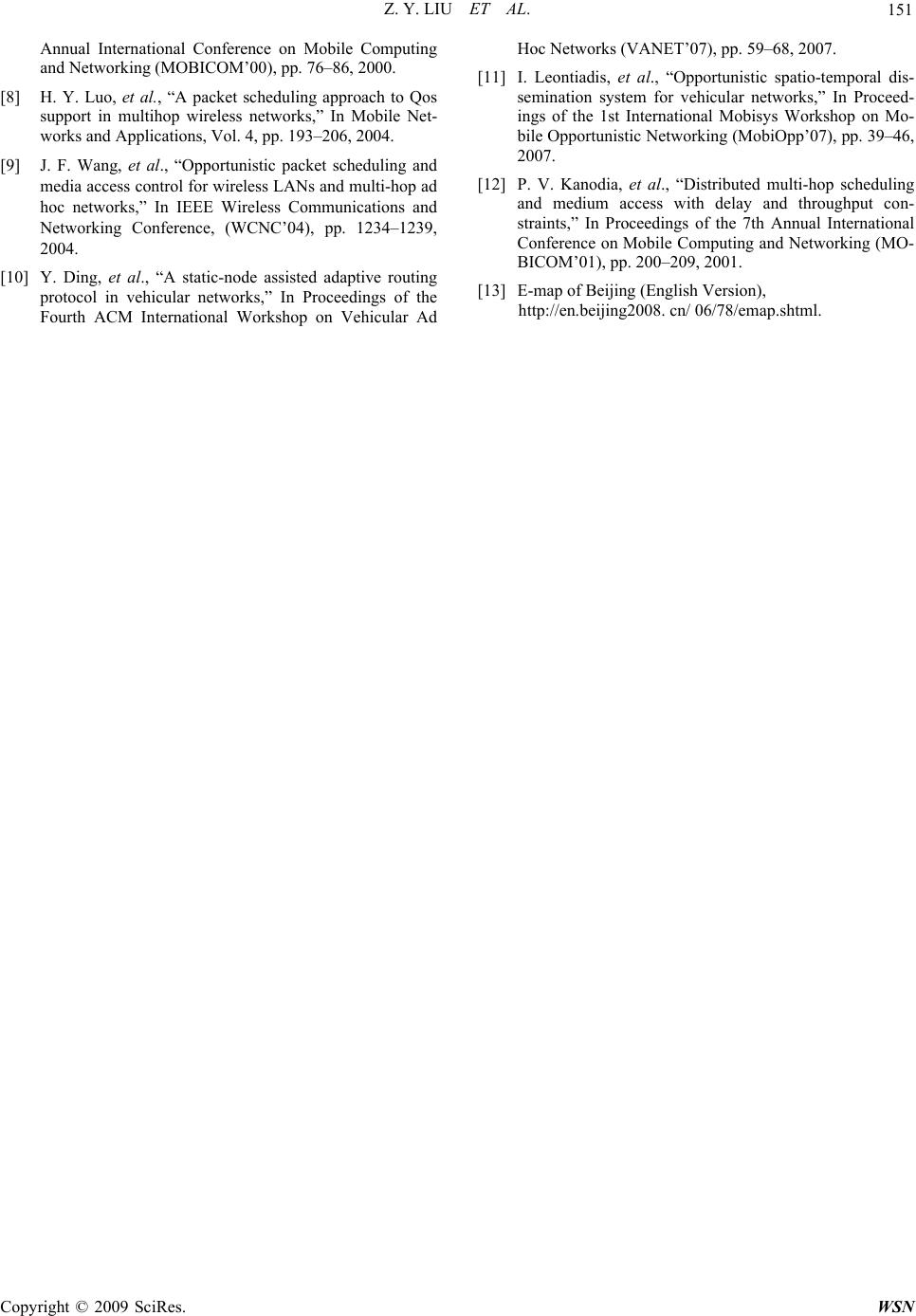 Z. Y. LIU ET AL. Copyright © 2009 SciRes. WSN 151 Annual International Conference on Mobile Computing and Networking (MOBICOM’00), pp. 76–86, 2000. [8] H. Y. Luo, et al., “A packet scheduling approach to Qos support in multihop wireless networks,” In Mobile Net- works and Applications, Vol. 4, pp. 193–206, 2004. [9] J. F. Wang, et al., “Opportunistic packet scheduling and media access control for wireless LANs and multi-hop ad hoc networks,” In IEEE Wireless Communications and Networking Conference, (WCNC’04), pp. 1234–1239, 2004. [10] Y. Ding, et al., “A static-node assisted adaptive routing protocol in vehicular networks,” In Proceedings of the Fourth ACM International Workshop on Vehicular Ad Hoc Networks (VANET’07), pp. 59–68, 2007. [11] I. Leontiadis, et al., “Opportunistic spatio-temporal dis- semination system for vehicular networks,” In Proceed- ings of the 1st International Mobisys Workshop on Mo- bile Opportunistic Networking (MobiOpp’07), pp. 39–46, 2007. [12] P. V. Kanodia, et al., “Distributed multi-hop scheduling and medium access with delay and throughput con- straints,” In Proceedings of the 7th Annual International Conference on Mobile Computing and Networking (MO- BICOM’01), pp. 200–209, 2001. [13] E-map of Beijing (English Version), http://en.beijing2008. cn/ 06/78/emap.shtml. |

